Wei Zhou
Celine
HAD: HAllucination Detection Language Models Based on a Comprehensive Hallucination Taxonomy
Oct 22, 2025Abstract:The increasing reliance on natural language generation (NLG) models, particularly large language models, has raised concerns about the reliability and accuracy of their outputs. A key challenge is hallucination, where models produce plausible but incorrect information. As a result, hallucination detection has become a critical task. In this work, we introduce a comprehensive hallucination taxonomy with 11 categories across various NLG tasks and propose the HAllucination Detection (HAD) models https://github.com/pku0xff/HAD, which integrate hallucination detection, span-level identification, and correction into a single inference process. Trained on an elaborate synthetic dataset of about 90K samples, our HAD models are versatile and can be applied to various NLG tasks. We also carefully annotate a test set for hallucination detection, called HADTest, which contains 2,248 samples. Evaluations on in-domain and out-of-domain test sets show that our HAD models generally outperform the existing baselines, achieving state-of-the-art results on HaluEval, FactCHD, and FaithBench, confirming their robustness and versatility.
Affine Modulation-based Audiogram Fusion Network for Joint Noise Reduction and Hearing Loss Compensation
Sep 09, 2025Abstract:Hearing aids (HAs) are widely used to provide personalized speech enhancement (PSE) services, improving the quality of life for individuals with hearing loss. However, HA performance significantly declines in noisy environments as it treats noise reduction (NR) and hearing loss compensation (HLC) as separate tasks. This separation leads to a lack of systematic optimization, overlooking the interactions between these two critical tasks, and increases the system complexity. To address these challenges, we propose a novel audiogram fusion network, named AFN-HearNet, which simultaneously tackles the NR and HLC tasks by fusing cross-domain audiogram and spectrum features. We propose an audiogram-specific encoder that transforms the sparse audiogram profile into a deep representation, addressing the alignment problem of cross-domain features prior to fusion. To incorporate the interactions between NR and HLC tasks, we propose the affine modulation-based audiogram fusion frequency-temporal Conformer that adaptively fuses these two features into a unified deep representation for speech reconstruction. Furthermore, we introduce a voice activity detection auxiliary training task to embed speech and non-speech patterns into the unified deep representation implicitly. We conduct comprehensive experiments across multiple datasets to validate the effectiveness of each proposed module. The results indicate that the AFN-HearNet significantly outperforms state-of-the-art in-context fusion joint models regarding key metrics such as HASQI and PESQ, achieving a considerable trade-off between performance and efficiency. The source code and data will be released at https://github.com/deepnetni/AFN-HearNet.
Integrating SAM Supervision for 3D Weakly Supervised Point Cloud Segmentation
Aug 27, 2025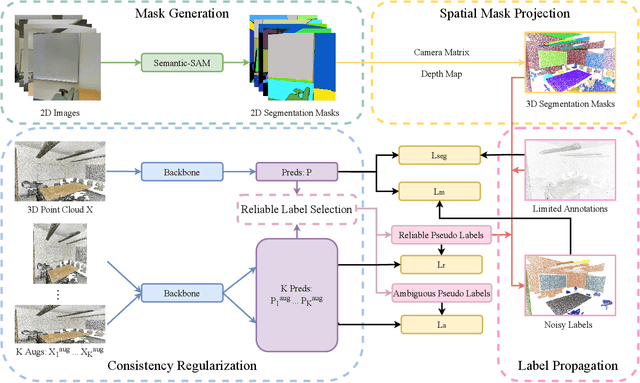
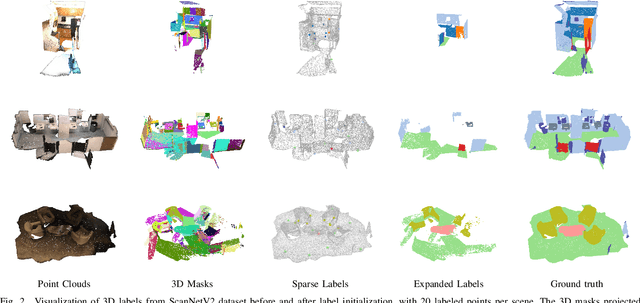
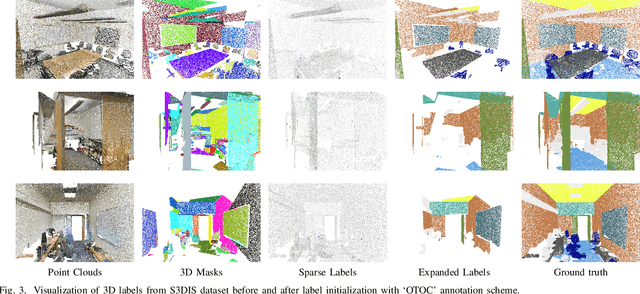
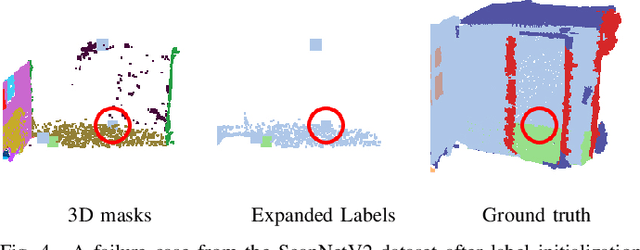
Abstract:Current methods for 3D semantic segmentation propose training models with limited annotations to address the difficulty of annotating large, irregular, and unordered 3D point cloud data. They usually focus on the 3D domain only, without leveraging the complementary nature of 2D and 3D data. Besides, some methods extend original labels or generate pseudo labels to guide the training, but they often fail to fully use these labels or address the noise within them. Meanwhile, the emergence of comprehensive and adaptable foundation models has offered effective solutions for segmenting 2D data. Leveraging this advancement, we present a novel approach that maximizes the utility of sparsely available 3D annotations by incorporating segmentation masks generated by 2D foundation models. We further propagate the 2D segmentation masks into the 3D space by establishing geometric correspondences between 3D scenes and 2D views. We extend the highly sparse annotations to encompass the areas delineated by 3D masks, thereby substantially augmenting the pool of available labels. Furthermore, we apply confidence- and uncertainty-based consistency regularization on augmentations of the 3D point cloud and select the reliable pseudo labels, which are further spread on the 3D masks to generate more labels. This innovative strategy bridges the gap between limited 3D annotations and the powerful capabilities of 2D foundation models, ultimately improving the performance of 3D weakly supervised segmentation.
ST-Raptor: LLM-Powered Semi-Structured Table Question Answering
Aug 25, 2025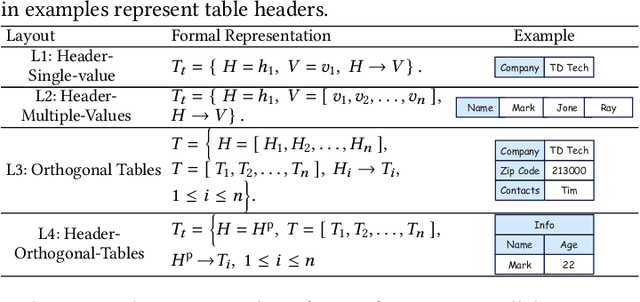

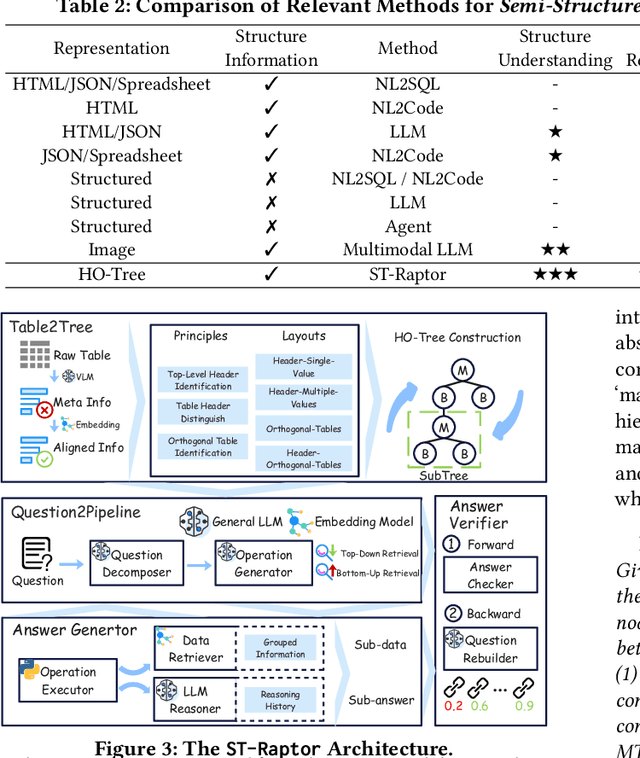
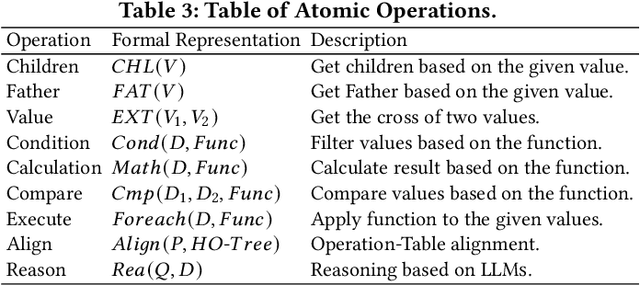
Abstract:Semi-structured tables, widely used in real-world applications (e.g., financial reports, medical records, transactional orders), often involve flexible and complex layouts (e.g., hierarchical headers and merged cells). These tables generally rely on human analysts to interpret table layouts and answer relevant natural language questions, which is costly and inefficient. To automate the procedure, existing methods face significant challenges. First, methods like NL2SQL require converting semi-structured tables into structured ones, which often causes substantial information loss. Second, methods like NL2Code and multi-modal LLM QA struggle to understand the complex layouts of semi-structured tables and cannot accurately answer corresponding questions. To this end, we propose ST-Raptor, a tree-based framework for semi-structured table question answering using large language models. First, we introduce the Hierarchical Orthogonal Tree (HO-Tree), a structural model that captures complex semi-structured table layouts, along with an effective algorithm for constructing the tree. Second, we define a set of basic tree operations to guide LLMs in executing common QA tasks. Given a user question, ST-Raptor decomposes it into simpler sub-questions, generates corresponding tree operation pipelines, and conducts operation-table alignment for accurate pipeline execution. Third, we incorporate a two-stage verification mechanism: forward validation checks the correctness of execution steps, while backward validation evaluates answer reliability by reconstructing queries from predicted answers. To benchmark the performance, we present SSTQA, a dataset of 764 questions over 102 real-world semi-structured tables. Experiments show that ST-Raptor outperforms nine baselines by up to 20% in answer accuracy. The code is available at https://github.com/weAIDB/ST-Raptor.
eMotions: A Large-Scale Dataset and Audio-Visual Fusion Network for Emotion Analysis in Short-form Videos
Aug 09, 2025Abstract:Short-form videos (SVs) have become a vital part of our online routine for acquiring and sharing information. Their multimodal complexity poses new challenges for video analysis, highlighting the need for video emotion analysis (VEA) within the community. Given the limited availability of SVs emotion data, we introduce eMotions, a large-scale dataset consisting of 27,996 videos with full-scale annotations. To ensure quality and reduce subjective bias, we emphasize better personnel allocation and propose a multi-stage annotation procedure. Additionally, we provide the category-balanced and test-oriented variants through targeted sampling to meet diverse needs. While there have been significant studies on videos with clear emotional cues (e.g., facial expressions), analyzing emotions in SVs remains a challenging task. The challenge arises from the broader content diversity, which introduces more distinct semantic gaps and complicates the representations learning of emotion-related features. Furthermore, the prevalence of audio-visual co-expressions in SVs leads to the local biases and collective information gaps caused by the inconsistencies in emotional expressions. To tackle this, we propose AV-CANet, an end-to-end audio-visual fusion network that leverages video transformer to capture semantically relevant representations. We further introduce the Local-Global Fusion Module designed to progressively capture the correlations of audio-visual features. Besides, EP-CE Loss is constructed to globally steer optimizations with tripolar penalties. Extensive experiments across three eMotions-related datasets and four public VEA datasets demonstrate the effectiveness of our proposed AV-CANet, while providing broad insights for future research. Moreover, we conduct ablation studies to examine the critical components of our method. Dataset and code will be made available at Github.
SGDFuse: SAM-Guided Diffusion for High-Fidelity Infrared and Visible Image Fusion
Aug 07, 2025Abstract:Infrared and visible image fusion (IVIF) aims to combine the thermal radiation information from infrared images with the rich texture details from visible images to enhance perceptual capabilities for downstream visual tasks. However, existing methods often fail to preserve key targets due to a lack of deep semantic understanding of the scene, while the fusion process itself can also introduce artifacts and detail loss, severely compromising both image quality and task performance. To address these issues, this paper proposes SGDFuse, a conditional diffusion model guided by the Segment Anything Model (SAM), to achieve high-fidelity and semantically-aware image fusion. The core of our method is to utilize high-quality semantic masks generated by SAM as explicit priors to guide the optimization of the fusion process via a conditional diffusion model. Specifically, the framework operates in a two-stage process: it first performs a preliminary fusion of multi-modal features, and then utilizes the semantic masks from SAM jointly with the preliminary fused image as a condition to drive the diffusion model's coarse-to-fine denoising generation. This ensures the fusion process not only has explicit semantic directionality but also guarantees the high fidelity of the final result. Extensive experiments demonstrate that SGDFuse achieves state-of-the-art performance in both subjective and objective evaluations, as well as in its adaptability to downstream tasks, providing a powerful solution to the core challenges in image fusion. The code of SGDFuse is available at https://github.com/boshizhang123/SGDFuse.
Modality-Aware Feature Matching: A Comprehensive Review of Single- and Cross-Modality Techniques
Jul 30, 2025Abstract:Feature matching is a cornerstone task in computer vision, essential for applications such as image retrieval, stereo matching, 3D reconstruction, and SLAM. This survey comprehensively reviews modality-based feature matching, exploring traditional handcrafted methods and emphasizing contemporary deep learning approaches across various modalities, including RGB images, depth images, 3D point clouds, LiDAR scans, medical images, and vision-language interactions. Traditional methods, leveraging detectors like Harris corners and descriptors such as SIFT and ORB, demonstrate robustness under moderate intra-modality variations but struggle with significant modality gaps. Contemporary deep learning-based methods, exemplified by detector-free strategies like CNN-based SuperPoint and transformer-based LoFTR, substantially improve robustness and adaptability across modalities. We highlight modality-aware advancements, such as geometric and depth-specific descriptors for depth images, sparse and dense learning methods for 3D point clouds, attention-enhanced neural networks for LiDAR scans, and specialized solutions like the MIND descriptor for complex medical image matching. Cross-modal applications, particularly in medical image registration and vision-language tasks, underscore the evolution of feature matching to handle increasingly diverse data interactions.
STFT-based Time-Frequency Mode Decomposition: A Fast and Robust Method for Multicomponent Signal Analysis
Jul 16, 2025Abstract:The decomposition of complex, multicomponent, and non-stationary signals into their constituent modes is a fundamental yet significant challenge in science and engineering. Existing methods often struggle with a trade-off among accuracy, computational cost, and the need for prior information such as the number of modes. This paper introduces time-frequency mode decomposition (TFMD), a novel framework for the fast, robust, and adaptive decomposition of such signals. TFMD operates on the principle that modes form contiguous high-energy regions in the time-frequency domain. Its non-iterative pipeline reframes signal decomposition as an image segmentation task: a signal is transformed into a spectrogram, which is then smoothed to enhance the continuity of these high-energy regions. A sequence of adaptive thresholding and connected-component labeling with size-based filtering is then employed to automatically segment the spectrogram and generate a mask for each mode. The modes are finally reconstructed via the inverse short-time Fourier transform. Validation on diverse synthetic signals demonstrates that TFMD accurately determines the number of modes and reconstructs them with high fidelity. Its performance is particularly strong in high-noise conditions. A comparative analysis confirms that TFMD provides robust, competitive performance across a wider variety of signal types, while a theoretical complexity analysis reveals its superior computational efficiency stemming from its non-iterative design. The method's practical utility is further demonstrated by successfully extracting modal responses from a real-world footbridge vibration signal. TFMD provides a computationally efficient and powerful paradigm for multicomponent signal analysis, offering a compelling balance of accuracy, versatility, and efficiency for large-scale or time-sensitive applications.
When Large Language Models Meet Law: Dual-Lens Taxonomy, Technical Advances, and Ethical Governance
Jul 10, 2025Abstract:This paper establishes the first comprehensive review of Large Language Models (LLMs) applied within the legal domain. It pioneers an innovative dual lens taxonomy that integrates legal reasoning frameworks and professional ontologies to systematically unify historical research and contemporary breakthroughs. Transformer-based LLMs, which exhibit emergent capabilities such as contextual reasoning and generative argumentation, surmount traditional limitations by dynamically capturing legal semantics and unifying evidence reasoning. Significant progress is documented in task generalization, reasoning formalization, workflow integration, and addressing core challenges in text processing, knowledge integration, and evaluation rigor via technical innovations like sparse attention mechanisms and mixture-of-experts architectures. However, widespread adoption of LLM introduces critical challenges: hallucination, explainability deficits, jurisdictional adaptation difficulties, and ethical asymmetry. This review proposes a novel taxonomy that maps legal roles to NLP subtasks and computationally implements the Toulmin argumentation framework, thus systematizing advances in reasoning, retrieval, prediction, and dispute resolution. It identifies key frontiers including low-resource systems, multimodal evidence integration, and dynamic rebuttal handling. Ultimately, this work provides both a technical roadmap for researchers and a conceptual framework for practitioners navigating the algorithmic future, laying a robust foundation for the next era of legal artificial intelligence. We have created a GitHub repository to index the relevant papers: https://github.com/Kilimajaro/LLMs_Meet_Law.
Gated Rotary-Enhanced Linear Attention for Long-term Sequential Recommendation
Jun 16, 2025Abstract:In Sequential Recommendation Systems (SRSs), Transformer models show remarkable performance but face computation cost challenges when modeling long-term user behavior sequences due to the quadratic complexity of the dot-product attention mechanism. By approximating the dot-product attention, linear attention provides an efficient option with linear complexity. However, existing linear attention methods face two limitations: 1) they often use learnable position encodings, which incur extra computational costs in long-term sequence scenarios, and 2) they may not consider the user's fine-grained local preferences and confuse these with the actual change of long-term interests. To remedy these drawbacks, we propose a long-term sequential Recommendation model with Gated Rotary Enhanced Linear Attention (RecGRELA). Specifically, we first propose a Rotary-Enhanced Linear Attention (RELA) module to model long-range dependency within the user's historical information using rotary position encodings. We then introduce a local short operation to incorporate local preferences and demonstrate the theoretical insight. We further introduce a SiLU-based Gated mechanism for RELA (GRELA) to help the model determine whether a user's behavior indicates local interest or a genuine shift in long-term preferences. Experimental results on four public datasets demonstrate that our RecGRELA achieves state-of-the-art performance compared to existing SRSs while maintaining low memory overhead.
 Add to Chrome
Add to Chrome Add to Firefox
Add to Firefox Add to Edge
Add to Edge